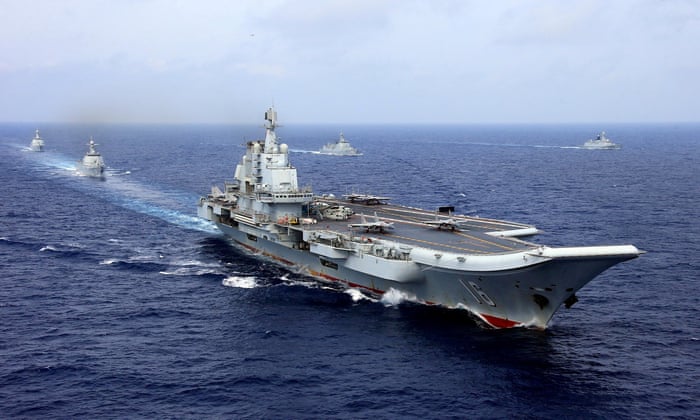China Concerns
"The Japanese government compiled a report on the South Pacific on May
17, affirming its targets of "maintaining and promoting environments
for realizing a free and open Indo-Pacific" and "ensuring the stability
and safety of the region."
"Free and open Indo-Pacific," an
expression frequently used by Japanese Prime Minister Shinzo Abe,
generally means the security of ocean routes from the Indian Ocean to
the Pacific through Southeast Asia. Stressing the importance of the rule
of law and freedom of navigation, the expression is aimed to check
China which is expanding its presence in the area."
"China
is sparking conflicts with countries around the South China Sea as it
builds artificial islands there as military outposts. The Japanese
government's report adopts the same expression out of concern that China
may resort to the same strategy in the South Pacific."
"China
envisions a line of defense from Japan's southern Ogasawara Islands to
Papua New Guinea via Guam and Saipan as its "second island chain"
strategy. An advisory organ to the U.S. Congress said in a report last
year that China is capable of rivaling the U.S. in air, sea and ground
forces in the island chain. In fact, China is expanding its military
influence to the South Pacific."
SUSUMU KURONUMA, Nikkei Asian Review
 |
| Japan Prime
Minister Shinzo Abe, center, poses with the leaders of Pacific island
countries in a photo session during their meeting in Iwaki, Fukushima
Prefecture, in May 2018. |
"Establishing a base in our neighbourhood would be a low-cost,
low-risk way for China to show off its growing military and diplomatic
reach and clout. Moreover, by ignoring the noisy complaints that would
surely emanate from Washington, Beijing would show that it is willing to
defy the United States."
"And it would send an unambiguous message to us here in Australia,
signalling Beijing’s rejection of our claims to our own sphere of
influence in the South Pacific, and sending a stark warning of China’s
reach and its capacity to punish us if we side too vociferously with the
US or Japan against it."
Hugh White, The Guardian
 |
| China’s aircraft carrier Liaoning takes part in a military drill of
Chinese People’s Liberation Army navy in the western Pacific Ocean in
2018. Photograph: China Stringer Network/Reuters |
Australia and Japan, once bitter enemies, now recognize in one another partners in a quiet offensive against a rising China's ambitions to dominate the western Pacific. China's economic clout has bought it alliances in the Pacific through investments and loans and the gratitude of Pacific island nations. China's steadily growing fleet is next in size only to that of the United States, lacking but the power of the U.S. major fleet units. China's dominance is already on view; its ambitions clear, leaving its neighbours in a state of high anxiety.
Japan and Australia have a robust trading relationship through the 2015 Japan-Australia Partnership, Australia is now Japan's fourth-largest trading partner, Japan Australia's second-largest trading partner. And they both, of necessity and of geography, have a large trading relationship with China. But then, which country globally does not?
Now the two countries are looking at another area of cooperation, examining a formal partnership in building an architecture of security through military cooperation, hoping in the process to invite other Asian countries, perhaps even European nations to join them. In the absence of a U.S. ongoing commitment to counter the growth of China's military, its intentions and influence among Pacific Island nations, the two countries see the vital utility of working together purposefully.
The historic agreement whereby the U.S. has its protective alliance with New Zealand and Australia, and that which Japan has so long relied upon with the U.S. commitment to Japanese security have both been tipped slightly askew with statements emanating from the White House in the last few years. The U.S. pulled its surprise removal from the Trans-Pacific Partnership. And seemingly snap decisions upending generations of treaties and long-held security suppositions have grown an aura of uncertainty.
Both Japan and Australia are trying to prepare themselves psychologically as well as practically for the potential of a post-U.S. Pacific, an absence of balance against the rising power of China. Geopolitical rivalry, particularly that between Japan and China recalls the turn of the 20th Century when an aggressive Japan invaded Korea and China, neither able to withstand the onslaught of a militarily assertive nation hungry for power.
Now it is Japan that has been long quiescent, and China in the ascendancy. The Chinese Peoples Liberation Army Navy, the largest in the world in numbers of seagoing ships still does not compare to striking power of the U.S. Navy with its carrier battle groups and large nuclear submarine fleets, but it is inexorably catching up, to the concern of its neighbours, in particular Australia and Japan.
Their concern is that should the U.S. withdraw from the far Pacific not only Australia and Japan but South Korea, Vietnam, Singapore, the Philippines and other island nations will be challenged to push back against China, or simply resign themselves to the inevitable. Both Australia and Japan have their own considerable naval power; Australia with 31 major fleet units -- submarines, assault landing ships, frigates, destroyers. While Japan has the third largest navy in the world with 65 frigates, destroyers, submarines and other ships.
But a challenge to China's ambitions of total conquest? Doubtful.
 |
| Australia's then-Prime Minister Malcolm Turnbull, talks with his Japanese
counterpart Shinzo Abe during a meeting of Japan's National Security
Council at Abe's official residence in Tokyo. 2018. Picture: AP |

Labels: Alliance, Australia, China, Domination, Japan, Security, Trade





<< Home